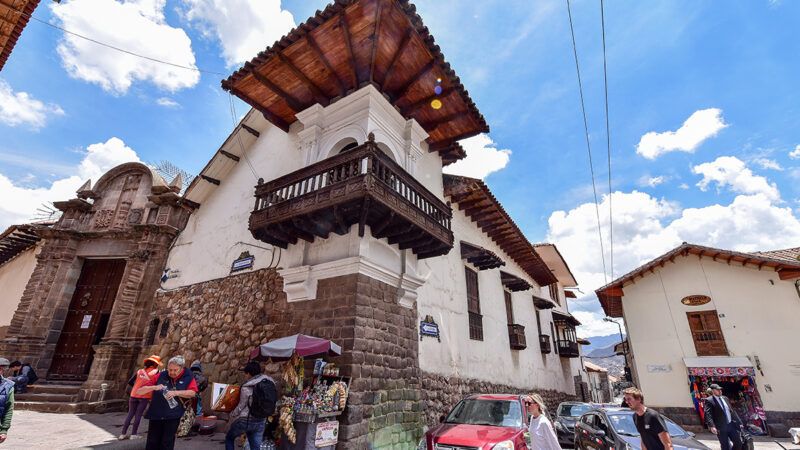An Empty Pool in Peru Is a Monument to the Drawbacks of Historic Preservation
Cusco earned a World Heritage Site designation from the United Nations. That's not always a good thing.

When the Spanish colonized Peru in the 16th century, they tore down the Incan temples and palaces, leaving the base level of original stone masonry in place. On top of those they built European-style white stucco walls, ornate baroque stonework, and intricately carved wooden balconies. This fusion of Incan and colonial architecture, particularly in Cusco, helped earn the city the designations of Historical Capital and Tourism Capital of Peru.
On May 21, 1950, an earthquake rocked Cusco, damaging approximately half of the city's buildings. The worst destruction affected old adobe houses and colonial-era churches, including the Church of Santo Domingo, which was built atop the Coricancha ("Temple of the Sun," dedicated to the Incan sun god). Spanish chronicler Pedro Cieza de León once marveled at the temple's "excellent masonry," noting that "the stones themselves are so well worked that no joining or cement can be seen." He was referring to the Incan technique of ashlar masonry, in which large, hand-cut stones are shaped to fit perfectly together—so well, in fact, that their structures survived the quake while newer additions crumbled.
Cusco's history stretches back even further, and more treasures are still being found. In 2008, archaeologists uncovered ruins of an ancient temple, roads, and irrigation systems credited to the pre-Inca Killke culture, likely dating back to the 12th century. Killke ceramics have also been found throughout the city. Due to its proximity to Machu Picchu, Cusco is sometimes thought of as merely a gateway to one of the New Seven Wonders of the World, but its own rich history has been attraction enough. In 1983, the United Nations Educational, Scientific, and Cultural Organization (UNESCO) designated Cusco a World Heritage Site, recognizing its extraordinary cultural significance.
That global recognition hasn't always benefited Cusco's residents. When a community development program began constructing a pool near the historic Sapantiana Colonial Aqueduct, it carefully followed guidelines to preserve the surrounding area. Late in the project, however, a final review uncovered Killke artifacts in the nearby San Blas neighborhood. This marked the whole area as a protected site, and the project was abruptly halted.
Today, visitors can see children running through the empty concrete rectangle that was meant to hold water, or down the slope intended for a waterslide. But they won't be swimming—because the pool was never completed.
Believed to be the oldest continuously inhabited city in South America, Cusco has always balanced reverence for the past with adaptation to the present. It's what the Incas did when they absorbed the Killke culture, what Peruvians did after Spanish colonization, and what they do today to welcome millions of visitors each year. Cusco shouldn't fear losing its World Heritage designation. The Peruvian people are clearly proud of their history, and they deserve credit for preserving the past. They also deserve a working pool.
This article originally appeared in print under the headline "UNESCO's Blessing, Cusco's Burden."
Editor's Note: As of February 29, 2024, commenting privileges on reason.com posts are limited to Reason Plus subscribers. Past commenters are grandfathered in for a temporary period. Subscribe here to preserve your ability to comment. Your Reason Plus subscription also gives you an ad-free version of reason.com, along with full access to the digital edition and archives of Reason magazine. We request that comments be civil and on-topic. We do not moderate or assume any responsibility for comments, which are owned by the readers who post them. Comments do not represent the views of reason.com or Reason Foundation. We reserve the right to delete any comment and ban commenters for any reason at any time. Comments may only be edited within 5 minutes of posting. Report abuses.
Please to post comments




The Peruvian people are clearly proud of their history, and they deserve credit for preserving the past. They also deserve a working pool.
This is mind-bogglingly stupid.
1) Nobody deserves a pool.
2) #1 shows you're not a libertarian.
3) -13.53, -71.95. Raze it, kill anyone there, dig a hole, bury them under it, and then fill it with water. Pool!
4a) You would literally never say this to anyone in America. FFS, you probably do land acknowledgements.
4b) Unless you're one of those kinds of people, who do the land acknowledgement and then refuse to turn it back over to them.
5) Today, visitors can see children running through the empty concrete rectangle that was meant to hold water, or down the slope intended for a waterslide. - Sounds like they've made do and are still enjoying themselves. Don't assume that because a kid has never seen a Nintendo that he doesn't know how to amuse himself with a stick and a ball. That's super duper elitist.
'It's what the Incas did when they absorbed the Killke culture'
"Absorbed"? Is that like genocide, but not done by some hated Euro-white culture?
Or were they absorbed in their digestive tracts?
No pool!?!! Ok...now I know why they're fleeing here under asylum. The horror!
A pool is a human right!
Does that include the gene pool?
It's spelled and pronounced "Cuzco". motha fuckas